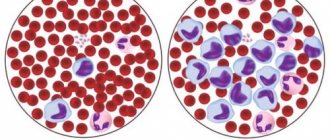Standard gestation lasts nine months, during which the mother repeatedly undergoes a lot of tests and undergoes various hardware tests. Sometimes the results may not correspond to accepted standards, then additional studies are again prescribed, and, if necessary, treatment. Sometimes a mother's glycated hemoglobin is tested during pregnancy; this test is prescribed to monitor blood sugar levels.
At the slightest sign of discomfort, you should seek medical help
What is this
Glycosylated hemoglobin during pregnancy is an indicator of the content of hemoglobin protein substance combined with glucose in a woman’s blood. A traditional blood sugar test does not always diagnose the presence or absence of diabetes. It often happens that during an examination, one analysis shows a normal sugar level, and another shows an increased sugar level. In such a situation, to clarify the picture, a repeat diagnosis is prescribed; if the results are elevated again, the patient is referred for a study of glycated hemoglobin.
What does this analysis show and why is it preferable? Simply, such diagnostics help to identify the level of sugar in the bloodstream over the past three months. Pregnant women have certain peculiarities in relation to this study, but more on them later.
Glycated hemoglobin is normal in pregnant women
Glycated hemoglobin is an indicator of the percentage of hemoglobin protein combined with glucose in the patient’s blood.
In ordinary cases, the usual blood sugar test does not make it possible to make an accurate diagnosis and determine whether the person being examined has diabetes or not. Surely you have heard that one person, at different times of examination, either had elevated sugar levels or not. According to the diagnostic scheme, the doctor prescribes repeat testing; if it is disappointing, you must take a test for glycated hemoglobin. Why is it considered reliable and more accurate? It's simple - it allows you to determine the sugar level in the body over the past 3 months.
Certain features appear in pregnant women during the testing process, which ones are discussed below.
The importance of glycated hemoglobin
Early diagnosis of pathologies, metabolic disorders and diabetes helps the doctor to navigate in time and prescribe the appropriate treatment to the patient. Therapeutic measures in most cases help to avoid the occurrence of serious complications, due to which the patient’s condition can sharply worsen.
This analysis is also indicated for the following identified violations:
- metabolic disorders in children;
- gestational diabetes, first manifested in a woman while carrying a baby;
- diabetes categories 1-2 in women who became pregnant while already sick and registered;
- diabetes with concomitant serious disruptions in kidney function;
- hyperlipidemia;
- if previously identified diabetes mellitus is inherited;
- high blood pressure.
Moreover, by taking blood samples for glycated hemoglobin, many patients were able to quickly identify cardiac pathologies, abnormal development of the cardiovascular system as a whole, and the appearance of neuropathy.
The process of drawing blood for analysis
The biomaterial for determining glycated hemoglobin is venous blood or blood taken from a finger - in this case it depends on the type of sensitive analyzer.
There is no special way to prepare for the procedure. However, you should not eat food at least 5 hours before taking the material; ideally, you need to wait 8 hours and come for examination on an empty stomach. Blood is donated early in the morning; tea and carbonated drinks are also prohibited.
There should not be any unusual painful sensations during the process. Depending on the general condition, the patient may feel unwell when collecting venous blood, but this is a temporary ailment - warn the medical staff about possible negative consequences, and if you feel something is wrong, lie down on the couch for a few minutes and breathe calmly, wait until the condition improves.
You can come back for testing in 3-4 days; the exact time frame will be indicated by a medical laboratory worker.
Norm of glycated hemoglobin in pregnant women
During the process of bearing a child, glycated hemoglobin determined in a pregnant woman should not reach no more than 6.5% of the total hemoglobin.
As for expectant mothers who have already been diagnosed with diabetes, we are more likely talking about constant monitoring of blood sugar and its adjustment. Of course, you shouldn’t expect standard values, but you still need to monitor carbohydrate metabolism.
In any case, there is a theory that any pregnant woman should undergo this type of testing every 1.5 months. When interpreting the results, the doctor must take into account the general condition of the expectant mother, because pregnant women often suffer from anemia, loss of strength and fainting, and some experience endless vomiting. You should not be surprised if the glucose level in this state of the body leaves much to be desired, but this in no way means that the woman has diabetes.
Therefore, when making a diagnosis, the doctor should be extremely careful.
Significance of the Study
Identification of pathological metabolic failures and diabetes in the early stages of development allows timely selection of the most effective therapy. Such timely therapy helps to avoid dangerous complications that seriously worsen the condition of patients. When conception occurs in patients prone to diabetes, the study of glycated hemoglobin is the most optimal method for determining blood sugar.
In pregnant girls, glucose levels are characterized by uneven growth, so routine tests for blood sugar may give inaccurate results. Typically, the maximum increase in pregnant women is observed at 8-9 months. But in healthy girls, a slight jump in sugar in the bloodstream usually does not carry any threats or negative consequences. If the patient has previously been diagnosed with diabetes, then with the help of such an examination it is possible to ensure constant monitoring of sugar and make the necessary correction in a timely manner. The norm for glycated hemoglobin during pregnancy is generally similar to that for ordinary patients.
Indications for testing
For pregnant girls, glycated hemoglobin protein testing is prescribed if there are certain indications. Particularly suspicious symptoms are those that indicate incipient or developing diabetes. Typically the indications for the procedure are:
- Persistent infectious pathologies;
- Insatiable thirst and constant dry mouth;
- Fatigue fairly quickly;
- Weakening of visual acuity;
- Long-term healing of wound injuries;
- Frequent urination;
- Metabolic disorders;
- Hyperlipidemia;
- Gestational diabetes;
- Risk of hereditary diabetes;
- High blood pressure;
- If the pregnant woman already suffers from diabetes, etc.
In addition, a study of the level of glycated hemoglobin allows timely detection of the presence of cardiac pathologies, abnormal development of cardiovascular structures or neuropathy.
Description and indications
During pregnancy, a number of changes occur in the female body. This may be not only a hormonal surge, but also an increase in blood sugar. Therefore, it is important to monitor this indicator in order to notice developing pathology in time. In most cases, the amount of glycated hemoglobin in the blood of a pregnant woman changes, but does not deviate from the existing norm.
Thanks to the analysis, you can see changes over the last 2-3 months. If the norm is exceeded, there is a high risk of developing gestational diabetes. This disease can occur if the following factors are present:
- polyhydramnios;
- weight problems;
- genetic predisposition to diabetes;
- polycystic ovary syndrome;
- a miscarriage that happened earlier.
Despite the fact that such an analysis allows diagnosing the disease in the early stages, it is performed extremely rarely. Instead, doctors prefer to perform a glucose tolerance test.
Indications for testing glycated hemoglobin protein are symptoms that indicate the onset of diabetes. These include:
- poor visual acuity;
- metabolic problems;
- constant dry mouth;
- fast fatiguability;
- hyperlipidemia;
- frequent urination;
- high pressure.
Analysis of the amount of glycated hemoglobin allows you to diagnose cardiac pathologies, as well as anomalies in the cardiovascular system. If treatment is not started in time, high blood sugar levels can have a negative impact not only on the expectant mother, but also on the development of the child himself.
Normal during pregnancy
Any vitamin supplements should only be taken as prescribed by a doctor.
Normally, glycated hemoglobin for pregnant women should be in the range of 4.5-6.5% of the total hemoglobin protein. If the patient has a history of diabetic disease, then the levels of glucose-bound hemoglobin will be many times higher than normal. The usual norm of glycated hemoglobin HbA1c indicates the state of carbohydrate metabolism of a pregnant woman over the past 3 months.
If the patient suffers from diabetes, then according to WHO recommendations, she needs to strictly monitor hemoglobin levels at least once in each trimester, and ideally once every month and a half. If a pregnant woman's readings exceed acceptable values, this may indicate the development of gestational diabetes.
Norm and deviations of indicators
Based on the obtained result of glycated hemoglobin, we can conclude about the likelihood of developing diabetes during pregnancy.
HbA1c Results Interpretation Table
| Glycated hemoglobin | Decoding the result | Recommendations |
| Less than 5.7% | Glycemic levels are within normal limits, the risk of diabetes is minimal | No lifestyle adjustments required |
| From 5.7% to 6.0% | There are no signs of diabetes. The disease can develop due to poor diet and lifestyle. | You should limit the amount of carbohydrates in your daily diet |
| From 6.1% to 6.4% | There is a high risk of diabetes | Mandatory diet required |
| More than 6.5% | The indicator values indicate suspicion of diabetes of any type or gestational form of the disease. To confirm the diagnosis it is necessary to undergo additional examinations | Consultation with a specialist is necessary to choose treatment tactics for the disease. |
No new indicator standards have been developed for pregnant women. The target values are the same for all people.
Features of the study
To carry out such a diagnosis, it is necessary to obtain blood from a finger or a vein. No additional special preparations are required from the patient for blood collection. Unless you fulfill standard requirements such as donating biomaterial on an empty stomach, for this you are allowed to eat your last meal 5-8 hours before the test, so that at the time of blood sampling the stomach is empty. Also, in the morning before diagnosis, you should not drink coffee, tea or any carbonated drinks.
When collecting biomaterial, there should not be any special or unusual painful sensations. The doctor must look at the patient’s general condition; if he often fainted when donating blood, then the laboratory assistant must be warned in advance about this feature. If you feel unwell, you should also inform your doctor about this, lie down for a couple of minutes on some hospital couch, breathe calmly until your condition returns to normal.
Disadvantages and advantages of the research method
Many people will think, why do a glycated hemoglobin test when you can simply donate blood for sugar. But these methods have a lot of differences, which allow us to confidently state that determining the content of sugar-related hemoglobin is more preferable from a diagnostic point of view. The results of such a study are much more difficult to influence than a regular sugar test, which changes if the patient took a couple of sips of coffee or chewed gum in the morning and then went to donate blood. There are other advantages too.
- High accuracy and speed of diagnosis;
- It is possible to determine the presence of diabetes at the most rudimentary stages, when other methods are still uninformative;
- Based on the results, the doctor can assess how accurately the patient follows his instructions and fulfills the prescriptions for reducing sugar;
- This study is universal and suitable for patients of any age;
- The results are not affected in any way by colds, medications or physical activity. In fact, this method is considered universal.
But sometimes HbA1c testing can also show disadvantages. For example, this study costs much more than a standard sugar test. And medical institutions are not yet sufficiently equipped to carry out such diagnostics, so it is impossible to undergo such a complex study in many provincial and district hospitals.
If a woman suffers from anemia or hemoglobinopathy, then there is a risk that the results will be unreliable. If before the analysis the patient took a large amount of ascorbic acid or tocopherol, then the final results will be lower than the actual values. The results are also influenced by the patient’s own body systems, for example, thyroid hormones can distort the result if some kind of failure occurs in the endocrine system.
How to take it
Your doctor will tell you how to prepare for donating blood fluid.
The lack of strict preparation is one of the significant advantages of this diagnostic test over other similar tests. Blood can be taken from a finger or a vein, depending on the type of analyzer. The blood obtained from the patient is combined with an anticoagulant substance to prevent it from clotting, which significantly increases its shelf life.
The analysis should be carried out in a specialized laboratory equipped with the necessary equipment that can separate glycated hemoglobin from plasma. A variety of techniques can be used, such as immunological reactions, electrophoresis, column method, etc. Laboratory assistants give the greatest preference to liquid chromatography, which helps to identify glycosylated hemoglobin with maximum accuracy.
Interpretation of results
Deciphering the results of the study is quite easy, especially if you have at least the slightest idea about the values of a given hemoglobin fraction. But sometimes the data may differ if the study was carried out in different laboratories and in different ways. In addition, individual patient characteristics may influence interpretation. For example, in people with the same sugar level, a significant difference of up to 1% may be detected when testing hemoglobin bound to glucose.
We also cannot exclude the possibility of a false increase in glycated hemoglobin associated with an increased level of the fetal hemoglobin fraction, as well as with pathologies such as uremia or hemorrhages, in which the HbA1c level tends to decrease. Also, the level of this hemoglobin protein can be affected by other factors such as age and weight, body structure and character, as well as the presence of concomitant pathologies.
- If HbA1c is below 5.7%, then carbohydrate metabolism is at a normal level, and the risk of developing diabetes in this patient is almost zero.
- At rates of 5.7-6.0%, the likelihood of developing diabetes increases; dietary nutrition is indicated. But such indicators are the norm for pregnant women, because their hemoglobin tends to increase slightly.
- At a level of 6.1-6.4%, a high probability of developing diabetes is also diagnosed, but this is for ordinary people; for pregnant women, this is the upper limit of the norm for glycated hemoglobin.
- If HbA1c is above 6.5%, then for all patients this indicator means the onset of diabetes development.
It turns out that the lower the levels of glucose-bound hemoglobin, the higher the likelihood of developing diabetes.
Indications for testing
A test for glycosylated hemoglobin during pregnancy is prescribed by an endocrinologist if there are indications:
- Diagnosis of diabetes mellitus (when standard research methods do not allow an accurate diagnosis to be made, and confirmation of glycemia is required).
- Glucose control in women with diabetes mellitus (with a disease diagnosed before pregnancy).
- Assessment of blood glucose in gestational diabetes mellitus.
- Monitoring the degree of compensation for diabetes mellitus.
- Diagnosis of borderline conditions (impaired glucose tolerance - prediabetes).
According to WHO recommendations, the HbA1C test is recognized as the best method for assessing blood glucose concentration in diabetes mellitus. The analysis allows not only to determine the level of glycemia, but to assess the likelihood of developing complications and give a prognosis for this disease.
During pregnancy, the glycohemoglobin test becomes especially important. While waiting for a baby, there is a natural decrease in glucose tolerance. This condition occurs when insulin sensitivity decreases. Changes occur against the background of the influence of key hormones - progesterone, estrogen and corticosteroids and, according to the mechanism of their appearance, resemble the process of development of diabetes mellitus. In this regard, pregnancy is considered as a risk factor for the occurrence of pathology. Expectant mothers may develop gestational diabetes mellitus, a temporary impairment of glucose tolerance that goes away after the birth of the child.
To detect diabetes mellitus, all pregnant women are prescribed a blood glucose test. The test is carried out twice: at the first visit to the doctor and at 30 weeks. But a regular biochemical blood test does not always reflect true glycemia during pregnancy. The amount of glucose in expectant mothers can sharply increase or decrease, and one-time bad results are not yet a reason for diagnosis. If the sugar level is outside the normal range, the woman is asked to undergo a glucose tolerance test and also donate blood for glycated hemoglobin. Taken together, these methods provide a complete picture of the metabolism of carbohydrates in the body of the expectant mother.
The World Health Organization recommends that all people with diabetes have an HbA1C test at least once a quarter. During pregnancy, if indicated, the study can be carried out every 1.5-2 months. The values of a blood test taken in different laboratories may differ, which is due to different methods of analyzing the material. Endocrinologists advise testing in the same laboratory throughout pregnancy to avoid misinterpretation of the results.
Important to know : reducing HbA1C levels by 10% reduces the risk of developing diabetes complications by 45%.
Increased and decreased indicators
An increase in glycated hemoglobin protein is caused by diabetes of the first and second types, which lasts for quite a long time. This protein also increases in cases of iron deficiency anemia, alcohol intoxication, poisoning with substances from the group of heavy metals, or the presence of kidney failure, after surgery to remove the spleen.
The concentration of HbA1c decreases during blood transfusions, prolonged hypoglycemia, progressive hemolytic anemia, or against the background of severe blood loss, which provokes a fall in not only glycated, but also total hemoglobin protein.
Reasons for carrying out
For pregnant women and in normal situations, an examination may be prescribed based on certain indications for this. Common symptoms that precede diabetes mellitus should be highlighted:
- Dry mouth and very thirsty all the time;
- Frequent and prolonged urination;
- Fatigue;
- Long healing of wounds;
- Constant presence of infectious diseases;
- Decreased vision.
One of the key reasons why the level of glycosylated hemoglobin may be elevated in the blood is type 1 and type 2 diabetes mellitus. Also, irrational treatment of high glucose carries the risk of developing hyperglycemia, which increases the level of carbohydrate concentration.
Sugar control and risk groups
It is important to regularly check the data using the device
The blood sugar content of a woman carrying a baby may periodically change under the influence of hormonal levels or metabolic processes. The first time a sugar test is taken is when the patient is registered for obstetric registration. If deviations are found during the study, the doctor will prescribe the necessary examination after some time to track the dynamics of changes occurring in the woman’s blood. Only with this approach will diagnostics help obtain the most objective results.
But it is recommended to begin appropriate monitoring of sugar even before pregnancy in order to minimize any deviations in fetal development, etc. During pregnancy, monitoring sugar will help to avoid birth complications and eliminate possible deviations in the development of the baby. Pregnant women with poor heredity, over 30 years of age, with a large fetus (more than 4 kg), with excess body weight or a history of miscarriages, as well as with polyhydramnios are especially at risk of encountering such disorders and abnormalities.
If, nevertheless, elevated levels of glycated hemoglobin are detected, then it is necessary to follow the doctor’s dietary recommendations for the rest of the pregnancy and give up fast carbohydrates such as sweets and bread. Fatty foods, chocolate, condensed milk, mayonnaise and yoghurt, sugar and sausages, soda and juices are also prohibited. Diet restrictions are very important to observe, especially when carrying a baby, because the development of the baby, connected to the mother through the umbilical cord, depends on this. If a pregnant woman abuses such fatty and unhealthy foods, then the baby will simply be forced to eat the same unhealthy foods.
How to normalize results
To normalize HbA1c levels, experts recommend adhering to the following recommendations.
- First, you need to correct deviations in hemoglobin levels in the right direction so that the indicators return to normal. When monitoring a pregnant woman, a doctor should draw up a table to clearly track the dynamics of changes in the level of glycated hemoglobin protein.
- Reduced HbA1c levels are corrected with medications. A pregnant woman is prescribed to take vitamins and mineral components in combination with iron. Diet therapy with a high content of foods rich in iron is also indicated.
- If the results show borderline hemoglobin values, then the doctor should be more attentive to the management of this patient and prescribe her a preventive diet with a low carbohydrate content, which will help correct metabolic processes as necessary.
- If the hemoglobin content is 6.4% or slightly higher, then this indicates developing diabetes, so a strict diet and healthy lifestyle are prescribed, as well as taking the necessary medications.
It is extremely important for every woman to closely monitor her own health, especially during the period of preparation for conception and while carrying a child, and to monitor the slightest changes in well-being towards deterioration. Constant fatigue and frequent urination, a feeling of persistent thirst and dry mouth - all these signs may indicate the development of diabetes. Therefore, when they appear, you must be examined and contact a specialist in the field of endocrinology, who will prescribe the necessary studies to monitor glycosylated hemoglobin.
When carrying a child, a slight increase in glycated hemoglobin is considered a completely natural physiological reaction of the female body, because during this period enormous changes occur in all systems. If its level increases too much, reaching borderline conditions, then it is necessary to adjust the diet and undergo treatment with special drugs that will lower HbA1c without danger to the fetus.
Normal levels of glycated hemoglobin during pregnancy: explanation
Since the 17th century, research related to childbirth has been carried out.
All accumulated knowledge has made it possible to identify conditions and diseases that lead to a threat to the life of a woman and child, including termination of pregnancy. One of these pathologies is diabetes mellitus.
It is not a contraindication for pregnancy. Hyperglycemia is a high level of glucose in the blood. It leads to the development of diabetic fetopathy.
What does the indicator mean?
Fetopathy is the collective name for all complications in the fetus that develop with hyperglycemia. These are the large size of the fetus, accompanied by an increase in the size of the internal organs:
- heart;
- spleen;
- liver;
- various neurological disorders, etc.
The development of diabetic fetopathy in a pregnant woman can lead to premature birth and asphyxia of the baby during childbirth and fetal death even before birth, in the early stages of pregnancy - 4-8 weeks. In this regard, at the present time, a standard set of examinations of women in different trimesters of pregnancy has been created.
They do everything to allow a woman to safely go through the journey of bearing a child, giving birth to a healthy baby and maintaining her own health. Among the many tests that a pregnant woman must undergo is a blood glucose test. If the result is high, the doctor will prescribe additional tests:
- glucose tolerance test;
- glycated hemoglobin.
40% of human blood consists of formed elements. They are red blood cells. There are about 270 million hemoglobin molecules in one red blood cell; during the process of glycation, they combine with glucose particles to form glycated hemoglobin.
Glycation is an irreversible process, and its speed depends on the amount of sugar in the blood. Glycated hemoglobin will be higher than blood sugar for the last 3-4 months. The red blood cell stays in the blood for 120-140 days, then new red blood cells replace it.
Therefore, a blood test for glycated hemoglobin is presented as an average value over 3-4 months. An analysis such as glycosylated hemoglobin determines and shows how many percent of hemoglobin has attached glucose molecules.
Sometimes the indicator is underestimated; laboratories have special tables according to the standards.
Reasons for carrying it out
A person with impaired carbohydrate metabolism is a candidate for glycated hemoglobin analysis.
Carrying out this analysis allows the doctor to evaluate the effectiveness of treatment for carbohydrate metabolism disorders and may show violations.
During the period of bearing a child, a woman’s hormonal levels fluctuate, and the analysis may change upward. Blood glucose monitoring is a standard test, it is prescribed two times:
- at the first visit to the gynecologist;
- at 30 weeks.
At 30 weeks, a woman may experience elevated sugar levels during pregnancy. You need to do a blood test for glycated hemoglobin. After receiving the result, correct her treatment. This type of control helps to identify early manifestations of carbohydrate metabolism.
Attention!
Endocrinologists consider pregnancy a risk factor for the development of diabetes.
People with diabetes and pregnant women are also recommended by the World Health Organization to do this test every three months.
Preparing for the test and standards
Donating blood for this test does not require prior preparation. The study is carried out regardless of food intake, physical activity, or emotional stress. Blood values for glycated hemoglobin in the same person are not always identical if they were performed in different laboratories.
Therefore, for dynamic monitoring of indicators, it is best to do tests in the same laboratory. To perform the analysis, venous blood in a volume of 3 cm3 is used. Blood is drawn from a vein by a medical professional into a sterile tube and delivered to the laboratory for analysis.
After the examination, the pregnant woman is given a form on which the analysis result and reference values are displayed.
In the diagnosis of carbohydrate metabolism disorders, determination of the concentration of glucose in the blood of a pregnant woman is used. The norm during pregnancy for glycated hemoglobin is from 4.0 mm/l to 5.9 mm/l.
Glycated hemoglobin is usually designated as HbA1c, which is exactly how it is designated on the form with the analysis result.
The first priority, according to the recommendation of the International Diabetes Federation, is for people with diabetes to strictly follow the doctor’s instructions so that the level of glycated hemoglobin does not exceed 6.5%.
The result of glycated hemoglobin exceeding 8% informs the doctor that the treatment of diabetes mellitus is unsatisfactory and its correction is required. The following reasons may affect the analysis results:
- heavy bleeding;
- hemolytic anemia;
- Iron-deficiency anemia;
- blood transfusion;
- increased blood viscosity (hematocrit)
Interpretation of glycated hemoglobin results:
- 6% or less is normal, low risk of developing diabetes;
- 6 – 6.5% – the risk of developing diabetes is high;
- 6.5% or more – diabetes mellitus.
How to normalize results
Hemoglobin levels in pregnant women often fall, especially in the later stages, and sugar, on the contrary, rises. If a woman has a test result of less than 6% during pregnancy, then there is no reason to worry. It is necessary to repeat the analysis at 30 weeks of pregnancy. Stick to a normal diet and perform moderate physical activity.
If a pregnant woman has a result of 6-6.5%, this is a reason to consult an endocrinologist. Most likely, a diagnosis of “diabetes mellitus” will not be made, but carbohydrate metabolism disorders are already beginning. Endocrinologists, in such situations, recommend doing:
- Glucose tolerance test.
- Follow a low-carb diet.
- Take prescribed medications.
If a pregnant woman has a result of 6.5% or higher, this is already a reason for alarm.
When blood sugar increases in a pregnant woman, they speak of gestational diabetes mellitus. This condition is temporary and is detected only during pregnancy against the background of changes in hormonal status. After the birth of the baby, the hormonal levels level out, and the blood glucose level returns to normal or decreases significantly.
But during pregnancy, hyperglycemia causes great harm to the health of both the woman and the child. The risk of developing gestational diabetes mellitus in pregnant women is about 2-5%. Women who have gestational diabetes while pregnant have a high risk of developing diabetes later. Therefore, during pregnancy, when a diagnosis of gestational diabetes is made, it is necessary:
- Follow a low-carb diet.
- Move more.
- Control your weight.
- Do not ignore prescriptions of hypoglycemic drugs in the form of injections.
- Constantly be monitored by an endocrinologist.
Diabetes is diagnosed if several signs coincide:
- Fasting blood sugar is above 6.1 mm/l, after eating 2 hours, above 11.1 mm/l.
- The blood glucose result after the glucose tolerance test is also higher than 11.1 mm/l.
- The result of glycated hemoglobin is higher than 5.9%. A level from 5.9% to 6.5% is doubtful, and more than 6.5 mm/l is a high probability of diabetes.
- Sugar is detected in the urine.
If the values are below the norm for pregnant women, this condition is called hypoglycemia - a blood glucose level below 3.3 mm/l. Causes:
- In a person with diabetes, most likely due to taking an incorrect dose of a sugar-lowering drug.
- Exacerbation of existing diseases.
- Physical activity is higher than usual.
- Poor nutrition.
- Drinking strong alcoholic drinks.
Hypoglycemia is a dangerous health disorder. The person may lose consciousness. Especially if this happens at night and the person does not feel any deterioration in their health. It cannot prevent a developing complication in advance.
As first aid in this condition, it is necessary to give the person a concentrated sweet solution (sweet water, fruit juice).
To prevent the development of such conditions, it is necessary to adjust the intake of glucose-lowering drugs and their dose.
If a decrease in blood sugar is detected for the first time, and the person has never had diabetes, then you should not postpone a full examination.
It is necessary to take additional tests prescribed by the doctor, do an ultrasound of the abdominal cavity, MRI or CT examination.
Low levels of glycated hemoglobin can also be recorded in blood diseases, when red blood cells are either destroyed earlier than after 3-4 months, or have a non-standard shape and a small number of hemoglobin molecules in them, for example, with:
- aplastic anemia;
- infectious disease "malaria";
- alcoholism;
- renal failure.
There are risk groups for developing diabetes among pregnant women. This group may include:
- Pregnant women with a hereditary predisposition.
- Pregnant women over 35 years old.
- Women who had a large fetus in previous births.
- Obese pregnant women.
- Women whose previous pregnancies ended in miscarriages.
- Women who have high blood pressure during pregnancy.
A woman planning a pregnancy is required to undergo screening before becoming pregnant. So that, in case of changes in health indicators, the doctor has the opportunity to compare tests.
Pregnant women always need to remember that the state of their health is mirrored on the health of the baby she is carrying.
Any change in the body that goes beyond the norm can have a bad effect on the condition of the woman and child.
Attention!
Thirst, frequent urination, dry mouth are manifestations of diabetes.
You can self-monitor your blood sugar levels at home using a glucometer. This is a device for determining blood sugar levels. Currently, the use of a portable glucometer is available. You need to place a drop of blood on an indicator plate connected to the glucose oxidase biosensor apparatus, and after a few seconds the level of glucose in the blood is determined.
A person using a glucometer must not forget that if blood glucose is monitored with two devices from different manufacturers, the results may differ.
The glycemic result obtained with a glucometer will be 1-2 units higher than the result obtained in a medical institution.
Self-monitoring of blood sugar is one of the primary measures to eliminate carbohydrate metabolism disorders.
If a pregnant woman performs an analysis only for glycated hemoglobin, the information about carbohydrate metabolism is not very informative. Because sugar levels in pregnant women increase at 30 weeks and later.
To prevent this from ending badly, you need to know that diabetes mellitus diagnosed in a person requires mandatory treatment, as it leads to the development of serious complications. The woman does not feel the increase in blood glucose, but the baby suffers.
If the expectant mother refuses treatment for gestational diabetes mellitus, the baby gains excess weight, and by the beginning of labor it develops into a large fetus, which can cause complications during childbirth, including the death of the child and the mother in labor.
Source: https://sosud-ok.ru/krov/analiz/norma-glikirovannogo-gemoglobina-pri-beremennosti.html











